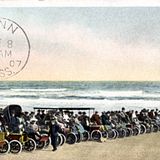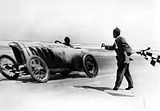Beginning in 1902, some of the first automobile races were held on the compacted sand from Ormond south to Daytona Beach. Pioneers in the industry, including Ransom Olds and Alexander Winton, tested their inventions. The American Automobile Association brought timing equipment in 1903, and the area acquired the nickname "The Birthplace of Speed." Lee Bible, in the record-breaking, but fatal, White Triplex, was less fortunate. Driving on the beach is still permitted on some stretches. The city was renamed Ormond Beach in 1949. Records set here during speed trial tournaments for much of the next eight years would be the first significant marks recorded outside of Europe. Motorcycle and automobile owners and racers brought vehicles that used gasoline, steam and electric engines. They came from France, Germany, and England as well as from across the United States. Tragically, the Ormond Garage caught fire and burned to the ground in 1976, destroying one of auto history's most important landmarks as well as antique cars owned by local residents who used the Garage as a museum. Sadly, all that remains is a historic marker, in front of SunTrust Bank, built on its ashes on East Granada Boulevard. Racing on Ormond Beach started in 1902. But the city's famous connection with racing began in 1903 when the Winton Bullet won a Challenge Cup against the Olds Pirate by two-tenths of a second. American records were set that year, and the world took notice. Incredibly, the flying mile world record was broken three different times by three different drivers in a 30-minute period that same year. The standing record of 92.31 mph was broken by Louis Ross in his steam-powered racer, the famous Wogglebug, at 94.73 mph. The Stanley legacy that led to Ormond Beach's longest-lasting automobile land speed record began in 1897. That year, twin brothers F.E. and F.O. Stanley from Massachusetts built their first steam car. By the turn of the century, their Stanley-Locomobile car was selling better than gas powered cars. The Stanleys competitive nature drove them to demonstrate their car's speed and durability. January 26, 1906, F.E. Stanley's Rocket Racer, driven by dare-devil Fred Marriott, set the mark that became Ormond Beach's most famous land speed record. The incredible speed of 127.659 mph held for four years, a remarkable achievement in a speed age where records sometimes fell within the hour. Racing moved to Indianapolis in 1911, but it wasn't long before Bill France and friends started racing on the beach, beginning what later became NASCAR. Daytona Beach soon took over the game started by its neighbor to the north, becoming a racing juggernaut of its own, today ironically overshadowing even Indianapolis. A proud heritage by any standard. In the meantime, Ormond is proud of its heritage as "Birthplace of Speed." In addition to the winter event that started with the 2003 Centennial, Ormond Beach has long celebrated this heritage with an annual Antique Car Show and nighttime Gaslight Parade on Thanksgiving Day weekend. Organizations and places of business alike in Ormond Beach celebrate the city's history of speed. Historic Billy's Tap Room, located near The Casements, has many historic photographs. Woody's BBQ restaurant on Granada has a new dining room decorated with historic racing photographs and murals. The MacDonald House, a Leisure Services facility for the city located on east Granada, is the headquarters and office for the Ormond Beach Historical Trust. The Trust maintains a small gallery with many photographs of the cars and personalities that drove and raced on the beach. It also has historic books and other items for sale. The Stanley Land Speed Record Centennial at the Birthplace of Speed is being presented by the Stanley Museum in collaboration with Ormond Beach Leisure Services. Major sponsors include the Motor Racing Heritage Association, the Ormond Beach Historical Trust, Carrabba's Italian Grill and National Parts Depot. Source: www.ormondbeach.org Ormond Beach Florida Auto Races 1905 Birthplace of Speed: Ormond Beach - We think of NASCAR and the Daytona 500 when it comes to cars, but Daytona was not the first place to attract speed buffs that honor belongs to its Northern neighbor, Ormond Beach. Ormond is called the birthplace of speed because it was the site of the first sanctioned speed trial.
|
 The "Line Up," Ormond-Daytona Beach, Fla. Dpc9141, Detroit Publishing Co., Curt Teich Postcard Archives, Lake County Discovery Museum. The "Line Up," Ormond-Daytona Beach, Fla. Dpc9141, Detroit Publishing Co., Curt Teich Postcard Archives, Lake County Discovery Museum. Barney Oldfield at Ormond Beach in 1910... Barney was the first to drive a car at 60 mph, and in 1910 he broke all existing speed records for the mile, two miles, and the kilometer in special runs at Ormond Beach, Fla. in the Blitzen Benz Barney Oldfield at Ormond Beach in 1910... Barney was the first to drive a car at 60 mph, and in 1910 he broke all existing speed records for the mile, two miles, and the kilometer in special runs at Ormond Beach, Fla. in the Blitzen Benz |